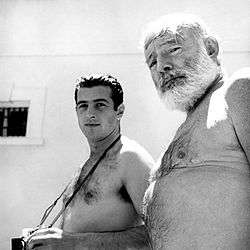Antonio Ordóñez
| Antonio Ordóñez | |
|---|---|
| Born |
Antonio Ordóñez Araujo February 16, 1932 Ronda, Spain |
| Died |
December 19, 1998 (aged 66) Seville, Spain |
| Nationality | Spanish |
| Occupation | Bullfighter |
| Spouse(s) | Carmen Cristina González |
| Children |
Carmen Cayetana Ordóñez González Belen Ordóñez |
| Awards |
Légion d'honneur Medalla al Mérito en el Trabajo |
Antonio Ordóñez Araujo (1932–1998) was a famous Spanish bullfighter.
Early life
Antonio Jiménez Ordóñez Araujo was born in Ronda, Spain, on February 16, 1932. His father was Cayetano Ordóñez, called Niño de la Palma, the prototype for the character of Pedro Romero, the matador in Ernest Hemingway’s novel The Sun Also Rises.[1][2]
Career
He was one of the top bullfighters of his time. As a matador, Ordóñez faced over 3,000 bulls. He retired in 1968, having fought over 60 bullfights in that year alone, but came back until finally retiring in 1988.
Social life

Ordóñez met a number of writers and actors, and he also starred in a few films. Antonio was a long time friend of Ernest Hemingway, whom he called Father Ernesto. Hemingway wrote an account of Ordóñez's rivalry with the matador Luis Miguel Dominguín (also Ordóñez's brother-in-law) titled The Dangerous Summer. Ordóñez also befriended Hollywood movie star Orson Welles, whose ashes were buried on Ordóñez's estate after Welles's death.
Family
Ordóñez was married to Carmen Cristina González. They had two children, Ana Belén Ordóñez and Carmen Ordóñez. Carmen married the matador Paquirri (killed by a bull in 1985). His grandchildren, by daughter Carmen, are bullfighters Francisco Rivera Ordóñez and Cayetano Rivera Ordóñez.
Death
Ordóñez died of liver cancer οn December 19, 1998.
Legacy
He was honored with a monument at the gates of La Malagueta bullring in Málaga and his ashes lie beneath the "toril" gate, opened to allow the bull to enter, in the oldest bullring in the world, in his home town of Ronda. His family owned the arena. There is a statue of him outside the arena.
See also
Notes
References
- Antonio Ordóñez, Spanish matador in Encyclopædia Britannica
- Hemingway, Ernest (1985). The Dangerous Summer; London: Hamish Hamilton Ltd; ISBN 0-241-11521-3